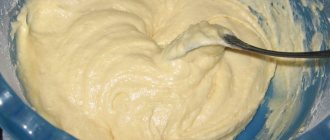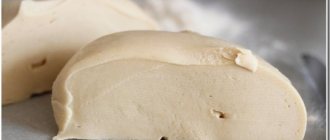Croissants are the most popular baked goods in France.
They are prepared almost everywhere: in pastry shops, cafes, restaurants and at home. Croissants are served with tea, cocoa or coffee.
Puff pastry requires certain knowledge and skills, so not every housewife can prepare it so that it is airy and crispy.
But today you can buy ready-made dough at any store, which greatly simplifies the process of making croissants.
Croissants from ready-made dough - basic principles of preparation
Croissants are made from puff pastry. In this case, both yeast and yeast-free products are used. The filling can be salty or sweet.
Chocolate, berries, jam, fruit, preserves or condensed milk are used as fillings for sweet croissants made from ready-made dough.
For savory croissants, the fillings can be very different. This could be cottage cheese with herbs, ham, cheese, mushrooms or other products.
The finished dough is defrosted, unrolled and placed on a floured table. The leaf is cut into long strips, the width of your palm. Then cut each strip into triangles.
Place the filling on the wide part and wrap the dough into a roll. Place the finished croissants from the prepared dough on a baking sheet lined with parchment. Each is brushed with beaten egg and baked in an oven preheated to 220ºC for a quarter of an hour.
Crispy, airy croissants. French classic with Austrian history.
Preparation of puff pastry dough.
1. 2 tsp. Dissolve yeast (with a small heap) in warm water (about 45 ml), leave in a warm place for 15 minutes.
2. Sift flour into a bowl, add sugar, salt, mix well, pour in warm milk, melted butter and prepared yeast. Mix everything well. Then place on the table and knead for about 10 minutes until the dough is smooth and elastic.
3. Place the finished dough in a plastic bag (in the form of a ball), tie it, but not tightly. Place in the refrigerator overnight (on the bottom shelf).
4. Prepare butter in the morning (250 g, from the refrigerator). To do this, put it in a plastic bag and beat it with a rolling pin to soften it. Mix with 40 g of flour by hand.
5. Place the butter on a piece of parchment paper and roll it into a square. Distribute the oil with a rolling pin (evenly!) over the entire volume of the paper square. Place in the refrigerator for 1 hour.
6. Remove the dough from the refrigerator. Make a cross-shaped cut on top, straighten the resulting segments from the middle to achieve a square. Roll out into a thin rectangular layer. Place a butter square in the middle. It is desirable that the butter rolls out easily in the dough and does not form hard pieces.
7. Fold the two opposite edges of the rectangle towards the middle of the butter square and pinch. Using your fingers, glue the dough together on the other edges (see photo). Thus, the butter will be “wrapped” in dough on all sides.
8. Turn the dough over, press with a rolling pin along the entire length, thus distributing the oil. Carefully roll out into a long rectangle. Trim the edges without butter (it makes very tasty buns!). Fold the rectangle in three layers (see photo). Place in a bag and refrigerate for at least 1 hour.
9. Roll out into a long rectangle and fold again into three layers. Repeat the procedure 3 more times.
10. Place the finished dough in a bag and refrigerate overnight.
11. Roll out the finished dough into a thin layer, cut into long triangles, and make small cuts at the wide ends. Add filling (for example, a piece of dark chocolate) or leave it without. Roll into bagels, folding ends. Place on a baking sheet lined with paper. Leave under the film to rise (in a warm place).
12. Brush the risen croissants with egg white (lightly beaten with 1 teaspoon of water), bake in a preheated oven (210-220o) until golden brown.
13. Sprinkle the finished croissants with powdered sugar (optional).
Bon appetit! Bon appétit!
Recipe 1. Croissants from ready-made dough with condensed milk
Ingredients
half a kilogram of puff pastry;
egg;
butter – 150 g;
150 g boiled condensed milk.
Cooking method
1. Defrost the dough. Sprinkle the table with flour and unfold a sheet of puff pastry on it. Roll it out slightly. Cut the sheet into wide strips. Then we cut each strip into triangles.
2. Melt the butter and mix with boiled condensed milk. Place a teaspoon of boiled condensed milk filling on the wide side of the triangle and roll the dough into a roll.
3. Place the croissants on a deco lined with baking paper. Beat the egg and brush each bagel with it.
4. Preheat the oven to 200 C. Place the deco with croissants in the oven and bake them for half an hour. Place the finished baked goods on a dish and sprinkle with powdered sugar.
French croissants with cherries and chocolate
At least, this is what legend says, according to which the first crescent-shaped bagel was baked once, namely in the 17th century, by a Viennese baker who was rejoicing over the victory of Austria over the Turks. Croissants came to France a hundred years later, along with the unfortunate Marie Antoinette - the guillotined queen was from Austria. And no one gets fat!
The convenient thing is that while the dough is proofing you can do something else. You won't believe the smell in the house.
But in order for all the French to receive their rightful croissant in the morning, someone, that is, the bakers, has to stay up all night. This someone must set the dough and knead the dough in the evening.
Then, at three o’clock in the morning, roll out the dough for the first time and layer it with butter, fold it in a special way, put it in the refrigerator for an hour, then roll it out again and butter it. Then roll it out again, and even with a special rolling pin, cut out a triangle, roll it into a multi-layer crescent bagel, leave it for an hour, and not in a draft - the croissant is afraid of drafts, and you can’t cover it with something like foil - it will stick, and only then start the actual baking.
You won’t sleep a wink all night, and as a result you’ll end up with a couple of dozen very prosaic bagels: you won’t be able to fit more into your home oven at one time. And the second batch of pseudo-croissants may not wait their turn, the technology here is such that everything is calculated in minutes. This dough cannot just stand there and wait, so each subsequent portion will most likely turn out to be worse than the previous one.
Starting from the wide end, roll the triangles into a bagel.
Recipe 4. Croissants from ready-made dough with ham and cream cheese
Ingredients
yeast-free puff pastry – 500 g;
curd cheese – 100 g;
200 g ham;
egg.
Cooking method
1. Completely defrost the finished puff pastry and divide it in half.
2. Roll out one part into a thin circle and cut it into triangular segments.
3. Grate the ham on a coarse grater. Place the cottage cheese in a plate with high sides and mash it with a fork. Add ham to it and stir.
4. Place some cheese and ham filling on the wide part of the triangle. We wrap the dough with the filling into a roll and place it on a baking sheet covered with parchment.
5. Place the baking sheet with croissants in the oven and bake at 180 C for half an hour. Serve the baked goods with broth or soup.
Homemade croissant from Alexander Seleznev
Salads and vinaigrettes. Soups and broths. Pancakes, pancakes, cheesecakes. Main dishes. Homemade preparations.
Dumplings and dumplings. By ingredient type. Ready meals. Greens, herbs, flowers. Would you like to please your loved ones with a delicious French breakfast? Then hurry up to prepare the croissant dough in advance so that you have a preparation for classic French baking on hand! Prepare delicious filled croissants for tea.
Dark dark chocolate, which the ancient American Indians enjoyed, is very valuable for the body. It contains a unique substance - theobromine, which is necessary for the full functioning of the brain, relieves pain spasms and promotes the active production of endorphins - the hormones of happiness. Cherry is a fragrant and tasty berry, but you can only enjoy the taste of fresh cherries in the summer months. Cherry compotes and preserves are among the most popular winter preparations. Vanillin is most often added to the dough.
It's easy and fast! You can add chocolate, jam or nuts inside. See how to make filled croissants right now and try them! One of my favorite breakfasts is croissants.
I cook it only on weekends, when I have time in the morning, but the recipe is not entirely traditional. I'll tell you how to make croissants from yeast dough.
France is considered the birthplace of delicious pastries.
I decided to prepare puff pastry for French croissants, I’m sharing my experiments on how to prepare dough for French croissants. Croissants with Nutella are an excellent option for delicious and sweet pastries for coffee or tea, and such croissants are very easy to prepare.
They also make a great snack for work or school. I present to your attention a simple recipe for making croissants with banana. Prepare them for your loved ones, they will lick your fingers!
Homemade croissants for breakfast, what could be better? For example, the French cannot imagine breakfast without croissants.
I want to share my favorite recipe with you! I love delicious baked goods, but I don’t really like fiddling with dough. For people like me, I have come up with a recipe on how to make a French croissant from ready-made puff pastry. It's easy to prepare and turns out delicious. A fragrant crispy croissant with coffee is a classic French breakfast.
Yes, not very healthy, but so romantic and delicious! What if you make these pastries yourself, in a new way? Let's try! Hello everyone: Sweet tooth, today I will tell you how to prepare croissant dough using a very simple recipe. Believe me, this recipe will definitely be on your list of favorites. Let's get started If you want to quickly bake something sweet for tea, this recipe is definitely for you!
Fast, simple and incredibly tasty! I advise you to repeat the recipe at home, even for no reason. There is nothing better with a cup of tea than warm and fragrant pastries, don’t you agree? So let's quickly prepare fragrant orange croissants for the whole family.
What is needed to get a real croissant?
- First of all, it is important to take care of the quality of the products - they must be fresh and of high quality. If at least the flour or butter leaves much to be desired, nothing will work. Speaking of butter, its fat content should be 84% or more.
- Not only the products must be of high quality, but also the equipment used for baking. Two types of ovens are used - conventional and combi oven. In the first case, the finished product is elastic, and in the second, it is crumbly. As you understand, there are different types of croissants, but if you still adhere to traditions, then preference should be given to crumbling. But the baked goods should not fall apart. It is this “golden mean” that is in greatest demand.
- It is important to follow the technology with great precision. The problem is that everyone has their own technology, because many have their own little secrets. Thanks to such secrets, some specialists achieve their unique taste, and often such a secret is family. Therefore, do not think that all the secrets will immediately be presented to you on a platter along with a croissant. Nevertheless, certain general patterns do exist. So, you cannot knead the dough too actively, because a large amount of oxygen will only damage the bun. At the same time, just a little bit of leaven is placed in the dough, otherwise it will also damage it. Even the mixing temperature is important - it should reach 16 degrees. It is equally important to adhere to other indicators - the thickness of the dough when cutting is 2.5-3 mm, turning the dough at 90 degrees when cutting, proofing the bun at a temperature of 25-26 degrees.
How to make Croissants with Cream
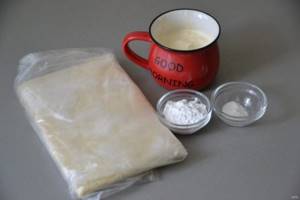
Prepare your ingredients.
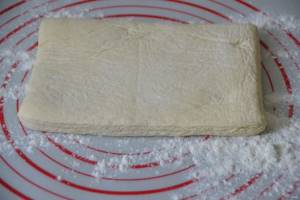
First of all, start preparing croissants; to do this, dust the work surface of the table with flour and lay out the dough.
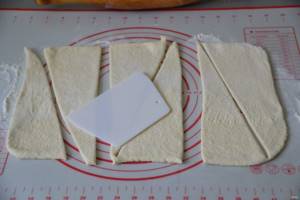
Roll out the dough into a rectangular layer, cut into triangles.
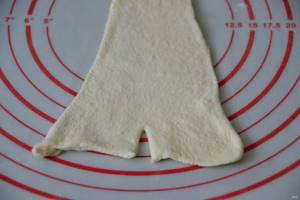
Make a small cut at the base of the triangle.
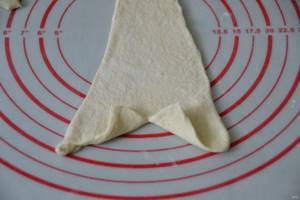
Fold in the corners of the dough and start rolling from the base to the top of the triangle.
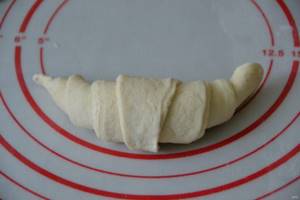
Gently bend the croissant into a crescent shape.
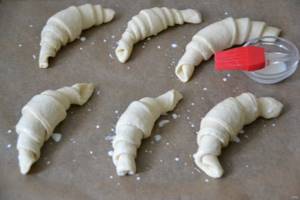
Place the croissants on a baking sheet and brush them with milk. Bake for 15-20 minutes at 180-200 degrees.

Cool the finished croissants to room temperature.
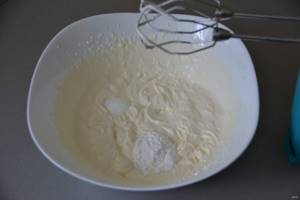
Prepare whipped cream. To do this, beat the cream until the mixer whisk begins to leave clear grooves, then add vanilla sugar and powdered sugar.
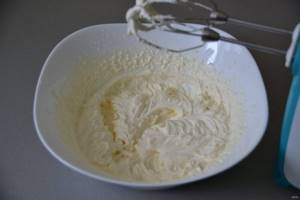
Whip the cream with powdered sugar and vanilla sugar until fluffy and thick.

Make a cut on the side of the croissant.

Use a pastry bag to fill the croissants with whipped cream, or sprinkle some powdered sugar on top.

Croissants with whipped cream turn out incredibly tender and tasty; in summer you can add raspberries or strawberries to them.
How the French are used to eating croissants
Is it worth saying that people are used to eating the national dish in a certain way? First of all, a croissant is most often served with coffee. Coffee is a separate topic in the life of every Frenchman. Perhaps this aromatic invigorating drink takes first place in popularity, noticeably ahead of wine, which, like the croissant, is considered one of the symbols of France. The French simply love to start their mornings with coffee! And at lunchtime, in principle, you wouldn’t mind taking a break from work for a steaming cup of drink. And if you serve it with a fresh croissant, it will be simply heaven!
Freshness is the next basic concept. A real croissant should be just baked. Many cafes will prepare it before your eyes, serving it still hot and aromatic. By the way, for this reason, many local residents tend to get up early in the morning. This is how just one bun can control the daily routine of an entire nation. And this is not surprising, because the French live in small things.
It's so easy to travel to France! Brew some strong coffee, grab a croissant to go with it, and you’re done. Understanding another country begins with sensations, and sensations are formed from little things. Therefore, do not neglect any way - especially such a delicious one - to feel like a Frenchman. You've probably already heard about online French courses? Sign up with us and we will help improve your knowledge of this beautiful European language.
About French baguettes
Speaking about croissants, one cannot fail to mention another bakery product that will definitely not leave anyone indifferent - the French baguette. This is a world-famous long loaf that is always associated with France. A Frenchman in a beret, rushing home for breakfast or dinner with a baguette under his arm is, of course, a stereotype, but very imbued with the spirit of the nation. Let's therefore talk about baguettes - where did they come from and why did they become a symbol of France, so that everyone who moved to France for permanent residence,
just can’t imagine life without them??
As often happens, a product that is considered exclusive today was once everyday and even invented in a situation of need. During the war, bakers were not allowed to open their establishments before four o'clock in the morning, which means they needed new technology that would allow them to prepare bread for the entire city in just a couple of hours. The baguette became such a technology. Since it is very narrow, it does not need much time in the oven to acquire all the qualities it needs and be ready for use. This saved the city from famine, and gave the French bakers an idea that, as we see, turned out to be very productive.
What is the difference between a real French baguette and fake and non-French ones?
- a real French baguette is always long and has notches.
- a real French baguette has a hard crust, under which the pulp is hidden. In this case, the pulp should be soft, but in no case raw.
- Many French baguettes are baked with various additives, such as nuts, as well as spices, dried fruits and other goodies that can greatly change the taste, but also make it special. A great opportunity to experiment. But if you are trying a baguette for the first time in your life, then it is better to take the classic version without additives. This will allow you to appreciate true French quality and traditional taste. Then, if you want variety, you can try something special.

- Due to the fact that the baguette has a hard, dry crust, the pulp inside remains soft for a long time, and the baguette does not dry out for several days. So it has become a very practical option for different situations. True, the baguette is long and inconvenient to carry, and if it is broken or cut, it loses many of its unique properties. However, usually the French and those who came to live in France for permanent residence have the habit of eating a baguette almost as soon as it was baked, and no problems arise.
- Finally, the baguette is made from flour that does not contain many calories. This allows the French to eat plenty of baguettes without gaining excess weight.
By the way, bakers played a big role in the history of Paris. Few people know, but it was with the money collected by bakers and entrepreneurs from among them that the famous Notre Dame de Paris Cathedral was built. And according to another legend, it was the bakers, who woke up earlier than everyone else due to the need to bake bread, who noticed the beginning of the enemy’s invasion of the city and managed to raise the alarm. So Paris, France, baguettes, croissants and bakers are all inextricably linked.
Description of preparation:
Let's prepare croissants without yeast at home.
The dough is made from flour, milk and sugar. Then it is greased with butter and rolled into a roll to form several layers (puff pastry). The finished dough is divided into triangles, butter and sugar are placed in the middle. Next, the croissants, greased with yolk and sprinkled with sesame seeds, are baked in the oven until cooked. Good luck! Purpose: For children / For an afternoon snack Main ingredient: Dairy products / Milk / Dough / Butter Dish: Baking / Croissants Diet: Baking without
Video on how to make a lot of croissants from ready-made puff pastry
Store-bought puff pastry always comes in handy for quickly baking pastries for tea.
In this recipe, the bagel is first baked and then filled. The method is convenient, because this way you get a lot of them at once.

In France, there is not a single coffee shop, bakery or other similar establishment that does not serve soft and fragrant croissants made from puff pastry with filling. You can use absolutely any filling for them, or cook without it at all. Such pastries will come in handy during family tea parties or get-togethers with friends.
Despite the fact that the dish is considered a high-calorie product, French women eat them morning, noon and night and do not have any special problems with weight. So, let's find out how to make delicious puff pastry croissants at home in just half an hour.





